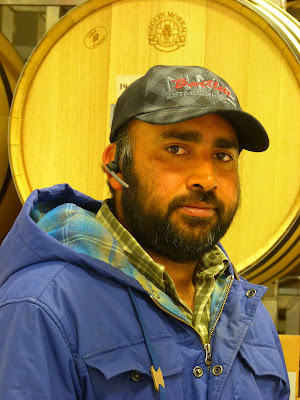Photo: Tantalus winemaker David Patterson
When Tantalus Vineyards sent me their releases for 2017 this
spring or early this summer, I decided to wait a few months before reviewing
them.
Bad idea if you were waiting on my reviews, which is not too
likely. Tantalus sells easily on its reputation.
But here was my rationale for taking my time.
The flagship wines at Tantalus are made with Riesling
grapes. Riesling takes its own sweet time to develop in bottle, so I decided to
give the Rieslings a few more months to really blossom.
Then life happened. It took me longer than anticipated to
get to the wines. I expect most of those wines are now sold out. Even so, I am
still going to report on my reviews. The information may be useful of you happened
to find some on a wine store shelf of in a restaurant. A little more time has
helped soften the often bright acidity of these Rieslings.
Under the direction of winemaker and general manager David
Patterson, Tantalus has firmly established itself as one of the Okanagan’s best
and most focussed wineries.
David, who received his winemaker training at Lincoln
University in New Zealand, credits tasting a 2008 Tantalus Riesling for firing
his interest in the Okanagan. He was then working for a wine retailer in
Vancouver after having worked vintages at wineries in Oregon, New Zealand and
Australia.
“I tasted it and it was wonderful,” David said of the 2008
Tantalus Riesling. “I joined them for harvest in 2009. It was my stroke 0f luck
that the winemaker at the time was Matt Holmes. I had worked with him in New
Zealand. He was moving on. So instead of just working the vintage, I ended up
becoming the winemaker in 2009.”
The Tantalus property, now about 75 acres in size, is one of
East Kelowna’s historic vineyards, planted in the late 1920s by a pioneer
grower, J.W. Hughes. He later sold the property to the Dulik family. They get
the credit for planting Riesling there in 1978. When Eric Savics, the current
owner, bought the property in 2004, he reduced the varieties being grown,
developing a tight focus that included more Riesling, along with Pinot Noir and
Chardonnay.
These are strong, terroir-driven wines. “For me, tasting
those wines, it is always remarkable how consistent the palate is,” David says.
“There are little variations but you can tell it is from the same property. It
does not matter on the winemaker or the vintage. I think we always have a very
consistent balanced palate.”
Here are notes on the recent releases.
Tantalus Riesling
2016 ($19.91). When I tasted this in July, I made a note that it should be
cellared for another year. The wine is simply yummy, with floral aromas and
with flavours of lemon and lime on the juicy palate. The bright racy acidity gives
the wine great freshness, with 17 grams of residual sugar to balance the wine’s
attack. 92.
Tantalus Old Vines
Riesling 2014 ($30.35). This wine is made from the 1978 planting of Clone
21B Riesling. Those vines deliver intensely concentrated aromas and flavours.
It begins with aromas of lemon and lime, with a complexing hint of petrol. The aromas
are echoed on the palate, along with the distinctive mineral notes of this
vineyard. The racy acidity gives the wine a dry finish; there is just enough
residual sweetness to prevent the wine tasting austere. The finish goes on and
on. This complex wine should peak in about 10 years. 94.
Tantalus Old Vines Riesling
Brut 2014 ($34.70). Only 200 cases of this exceptional sparkling wine were
made. It was disgorged after two years en tirage. The fine bubbles deliver
aromas of citrus and brioche, followed by flavours of citrus and apple. The
wine has a long, elegant finish with a touch of almond. 94.
Tantalus Blanc de
Noir 2014 ($27.74). This traditional method sparkling wine is made with
grapes from a 1985 block of Pinot Noir. The wine spent two years on tirage
before being disgorged. Rose petal pink in colour, the wine’s fine bubbles
create a lively display in the glass. The aromas and flavour recall
strawberries and pink grapefruit. The bubbles create a creamy impression on the
palate but the fresh acidity gives a crisp finish. 91.
Tantalus Juveniles
Chardonnay 2016 ($17.30). This wine was made from the fourth harvest of a
young Chardonnay block. Fermented with wild yeast, the wine is fresh and fruit forward,
with aromas and flavours of lemon and green apples. 88.
Tantalus Chardonnay
2015 ($26.00). This style of this wine pays tribute to White Burgundy. The
wine was fermented with natural yeast in French oak puncheons and barriques,
30% of which were new. The wine has aromas of citrus with a touch of vanilla.
Full on the palate, it has flavours of lemon, apple and nectarine. The wine is
elegant, with a refreshing focus of fruit on the finish. 92.
Tantalus Rosé 2016 ($19.09).
This is 60% Pinot Noir, 40% Pinot Meunier. Light pink in hue, the wine has
aromas and flavours of strawberry, raspberry and pink grapefruit. The finish is
crisp and dry; I might have preferred just a touch of residual sugar to fully bring
out the charm of the wine. 90.






















































